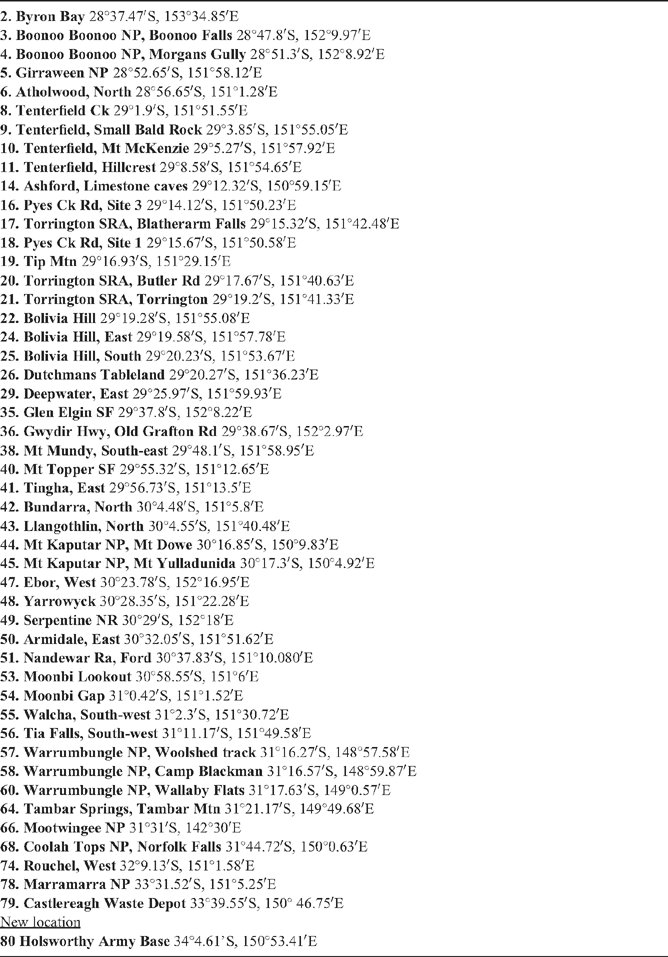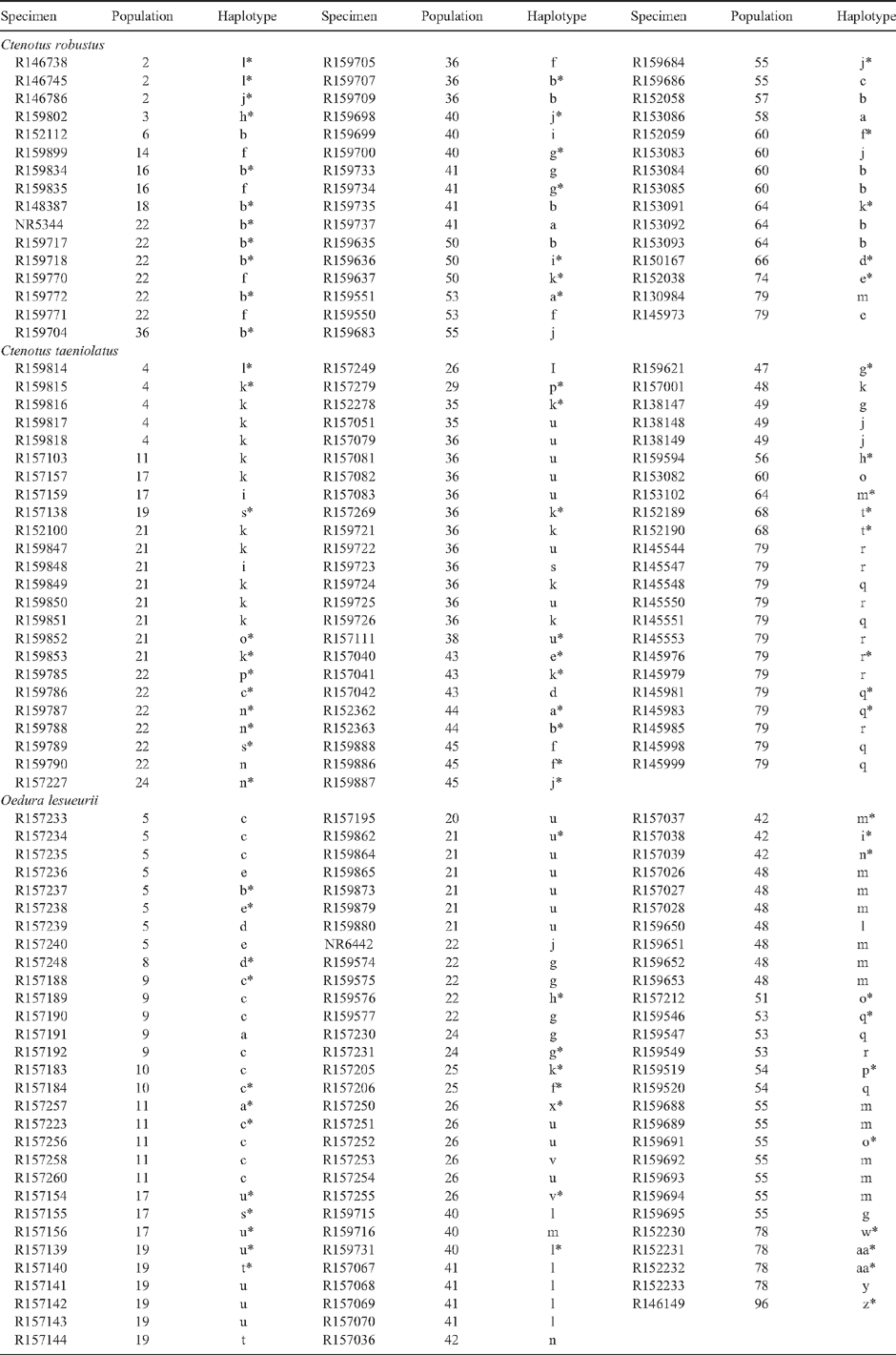Phylogeographic patterns in reptiles on the New England Tablelands at the south-western boundary of the McPherson Macleay Overlap
D. J. Colgan A C , D. O’Meally A B and R. A. Sadlier AA The Australian Museum, 6 College Street, Sydney, NSW 2010, Australia.
B Current address: Research School of Biological Sciences, The Australian National University, Acton, ACT 0200, Australia.
C Corresponding author. Email: don.colgan@austmus.gov.au
Australian Journal of Zoology 57(5) 317-328 https://doi.org/10.1071/ZO08088
Submitted: 21 November 2008 Accepted: 2 June 2009 Published: 20 November 2009
Abstract
Phylogeographic studies of eastern Australia have generally supported earlier biogeographical studies based on taxon distributions by concurring in the placement of significant intraspecific boundaries. Such studies may potentially clarify biogeographic boundaries that are presently unclear, such as the poorly defined southern edges of the McPherson Macleay Overlap. Here we investigate reptile phylogeography in the northern tablelands of New South Wales to study the south-western boundaries of the Overlap as these are especially uncertain. Cytochrome b sequences from Ctenotus robustus, C. taeniolatus and Oedura lesueurii, three lizard species widespread across the New England Tablelands, were analysed by examining single-strand conformational polymorphism and DNA sequencing. In both O. lesueurii and C. taeniolatus most deeper nodes within species define geographically localised clades. This was not the case for C. robustus. Boundaries between sister-group clades were discovered in multiple locations in the region – between Glen Innes and Armidale, between Armidale and Tamworth and to the south of the Liverpool Plains. The boundaries in C. taeniolatus and O. lesueurii were probably formed in at least two different periods. The phylogeographic patterns may be partly explained by glacially induced aridity cycles in the early Pleistocene or before.
Additional keywords: Ctenotus, gecko, McPherson Macleay Overlap, Oedura, phylogeographic boundary, skink.
Acknowledgements
We thank Gerry Swan and Stephanie Clark for assisting with collections, and the New South Wales State Government for funding through a Policy Enhancement Grant. Animals were collected for this project under the New South Wales National Parks and Wildlife Service Scientific Authority A1397 (Australian Museum), the Forestry Commission of New South Wales Special Purposes Permit for Research 5138 (Australian Museum). We thank Glenn Shea for extensive advice during the course of the project and two anonymous referees for constructive advice on a previous version of the manuscript.
Burbidge, N. (1960). The phytogeography of Australia. Australian Journal of Botany 8, 75–209.
| Crossref | GoogleScholarGoogle Scholar |
Couper, P. J. , Sadlier, R. A. , Shea, G. M. , and Worthington Wilmer, J. (2008). A reassessment of Saltuarius swaini (Lacertilia: Diplodactylidae) in southeastern Queensland and New South Wales; taxa, phylogeny, biogeography and conservation. Records of the Australian Museum 60, 87–118.
| Crossref | GoogleScholarGoogle Scholar |
Knowles, R. , Mahony, M. , Armstrong, J. , and Donnellan, S. (2004). Systematics of sphagnum frogs of the genus Philoria (Anura: Myobatrachidae) in eastern Australia, with the description of two new species. Records of the Australian Museum 56, 57–74.
Rossetto, M. , Crayn, D. , Ford, A. , Ridgeway, P. , and Rymer, P. (2007). The comparative study of range-wide genetic structure across related, co-distributed rainforest trees reveals contrasting evolutionary histories. Australian Journal of Botany 55, 416–424.
| Crossref | GoogleScholarGoogle Scholar |
Tamura, K. , Dudley, J. , Nei, M. , and Kumar, S. (2007). MEGA4: Molecular Evolutionary Genetics Analysis (MEGA) software version 4.0. Molecular Biology and Evolution 24, 1596–1599.
| Crossref | GoogleScholarGoogle Scholar | CAS | PubMed |
Thompson, J. D. , Gibson, T. J. , Plewniak, F. , Jeanmougin, F. , and Higgins, D. G. (1997). The CLUSTAL X windows interface: flexible strategies for multiple sequence alignment aided by quality analysis tools. Nucleic Acids Research 25, 4876–4882.
| Crossref | GoogleScholarGoogle Scholar | CAS | PubMed |

|



